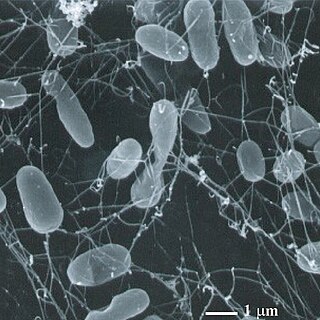
| Pyrolobus | |
|---|---|
| Scientific classification | |
| Domain: | |
| Phylum: | |
| Class: | |
| Order: | |
| Family: | |
| Genus: | Pyrolobus Blöch, Rachel, Burggraf, Hafenbradl, Jannasch & Stetter, 1999 |
| Species | |
Pyrolobus is a genus of the Pyrodictiaceae. [1]

| Pyrolobus | |
|---|---|
| Scientific classification | |
| Domain: | |
| Phylum: | |
| Class: | |
| Order: | |
| Family: | |
| Genus: | Pyrolobus Blöch, Rachel, Burggraf, Hafenbradl, Jannasch & Stetter, 1999 |
| Species | |
Pyrolobus is a genus of the Pyrodictiaceae. [1]

The Thermoproteota are prokaryotes that have been classified as a phylum of the Archaea domain. Initially, the Thermoproteota were thought to be sulfur-dependent extremophiles but recent studies have identified characteristic Thermoproteota environmental rRNA indicating the organisms may be the most abundant archaea in the marine environment. Originally, they were separated from the other archaea based on rRNA sequences; other physiological features, such as lack of histones, have supported this division, although some crenarchaea were found to have histones. Until recently all cultured Thermoproteota had been thermophilic or hyperthermophilic organisms, some of which have the ability to grow at up to 113°C. These organisms stain Gram negative and are morphologically diverse, having rod, cocci, filamentous and oddly-shaped cells.

The Desulfurococcales is an order of the Thermoprotei, part of the kingdom Archaea. The order encompasses some genera which are all thermophilic, autotrophs which utilise chemical energy, typically by reducing sulfur compounds using hydrogen. Desulfurococcales cells are either regular or irregular coccus in shape, with forms of either discs or dishes. These cells can be single, in pairs, in short chains, or in aciniform formation.
Thermoproteales are an order of archaeans in the class Thermoprotei. They are the only organisms known to lack the SSB proteins, instead possessing the protein ThermoDBP that has displaced them. The rRNA genes of these organisms contain multiple introns, which can be homing endonuclease encoding genes, and their presence can impact the binding of "universal" 16S rRNA primers often used in environmental sequencing surveys.
The Pyrodictiaceae are a family of disc-shaped anaerobic microorganisms belonging to the order Desulfurococcales, in the domain Archaea. Members of this family are distinguished from the other family (Desulfurococcaceae) in the order Desulfurococcales by having an optimal growth temperature above 100 °C, rather than below 100 °C.
Thermofilaceae are a family of archaea in the order Thermoproteales.
In taxonomy, the Thermoproteaceae are a family of the Thermoproteales.
In taxonomy, Caldivirga is a genus of the Thermoproteaceae.
In taxonomy, Thermocladium is a genus of the Thermoproteaceae.

Acidilobus is a genus of archaea in the family Acidilobaceae.
In taxonomy, Desulfurococcus is a genus of the Desulfurococcaceae.
Stetteria is a genus of archaeans in the family Desulfurococcaceae. Up to now there is only one species of this genus known, Stetteria hydrogenophila.
Sulfophobococcus is a genus of the Desulfurococcaceae.
Thermodiscus is a genus of archaea in the family Desulfurococcaceae. The only species is Thermodiscus maritimus.
Thermosphaera is a genus of the Desulfurococcaceae. They are a group of prokaryotic organisms which have been discovered in extremely hot environments such as sulfur springs, volcanoes, and magma pools. Isolates of Thermosphaera were first identified in 1998 from the Obsidian Pool in Yellowstone National Park.
In taxonomy, Geogemma is a genus of the family Pyrodictiaceae.
In taxonomy, Hyperthermus is a genus of the Pyrodictiaceae.
Pyrodictium is a genus in the family Pyrodictiaceae. It is a genus of submarine hyperthermophilic Archaea whose optimal growth temperature range is 80 to 105 °C. They have a unique cell structure involving a network of cannulae and flat, disk-shaped cells. Pyrodictium are found in the porous walls of deep-sea vents where the temperatures inside get as high as 400 °C, while the outside marine environment is typically 3 °C. Pyrodictium is apparently able to adapt morphologically to this type of hot–cold habitat.
Thermofilum is a genus of archaea in the family Thermofilaceae.
Ignisphaera is a genus of the Desulfurococcales. Ignisphaera aggregans is a coccoid- shaped, fourth type strain that is strictly anaerobes with anaerobic respiration. This archaea species are hyperthermophiles that were found in New Zealand's hot springs in Kuirau Park, Rotorua.

Pyrolobus fumarii is a species of archaea known for living and reproducing at extremely high temperatures that kill most organisms. P. fumarii is known as a hyperthermophile obligately chemolithoautotroph. In the simplest terms, this archaea grows best in warm temperatures ranging from 80 °C to 115 °C. It also uses preformed molecules as its energy source rather than light, inorganic as an electron donor, and CO2 is used as a carbon source. It was first discovered in 1997 in a black smoker hydrothermal vent at the Mid-Atlantic Ridge, setting the upper-temperature threshold for known life to exist at 113 °C (235.4 °F) with an optimal temperature of 106 °C. This species "freezes" or solidifies and ceases growth at temperatures of 90 °C (194 °F) and below.